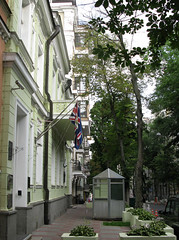21st July 2011
British Embassy Kyiv: if walls could talk
One of the striking things about Kyiv is the mixture of architectural styles across the city. This is true of the Ulitsa Desyatinna, where the British Embassy is a stone’s throw from the golden domes of the (rebuilt) St Michael’s Church and the mighty Soviet-era building that today houses our colleagues in the Ministry of Foreign Affairs. The Embassy building itself has a fascinating history, published today in full on our website.
9, Desyatynna Street
Like so many other buildings in Ukraine, the building’s past reflects the country’s turbulent history. It was originally built by the wealthy sugar baron, Simirenko, in 1899: there is a plaque to him on the Embassy facade, unveiled in 1995 by one of his descendants. After 1917 the building housed a post-revolutionary military staff and the forerunner of the National Academy of Sciences of Ukraine. It was later a meeting point for the Ukrainian Writers’ Guild led by Olena Teliha, who was murdered at Babyn Yar. After 1945, the building became an official guest house for foreign visitors including Tito, Castro and Nasser.
The building became the home of the British Embassy in 1992. Early British Ambassadors lived on the first floor which Simirenko had occupied 90 years before. Long-serving members of staff remember the elegant plaster decoration and heavy wooden furniture, including a large snooker table in the basement (alas now removed) made from Karelian birch.
The English polymath William Morris said that “old buildings do not belong to us only… they have belonged to our forefathers and they will belong to our descendants”. At a time when there is often a conflict between new developments and maintaining older structures in Kyiv and elsewhere, I hope that the Embassy building and the Simirenko plaque continue to inspire passers-by of the need to protect the historic heart which makes central Kyiv so unique and beautiful.
